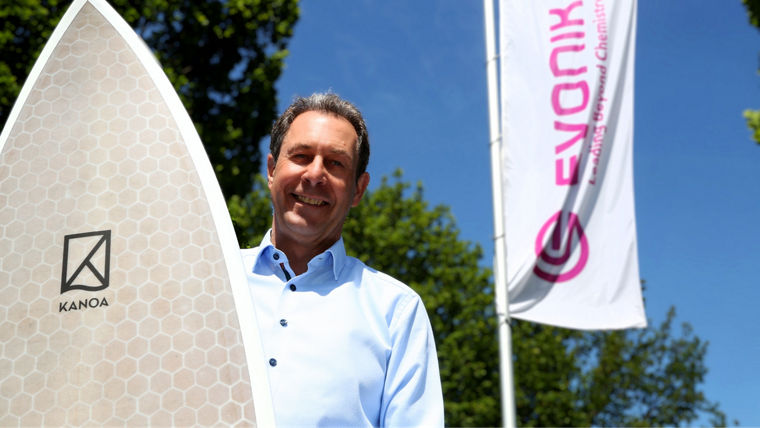The way surfers look at nature is often described as the surfer-environment paradox. On the one hand, many of the athletes are very close to nature: They love clean water and pristine beaches, organize waste collection campaigns, and observe climate change with concern. On the other hand, they also surf in remote corners and often open them up for tourism. The professionals also travel frequently and far to reach the top spots around the world. Most importantly, however, the material from which surfboards are made is a problem. Until now, the boards have been made from a firmly bonded collection of plastics that can hardly be separated and therefore cannot be recycled.
Thilo von Osterhausen wants to change that. With the help of Evonik, the 35-year-old entrepreneur is building boards for a circular economy. Von Osterhausen grew up in the surfing sector. His father founded the Gunsails company in Saarbrücken in 1984, in the early days of the windsurfing boom in Europe. The family-run company still exists today and is the largest German manufacturer of windsurfing products with sales of around five million euros. Thilo first stood on a surfboard at the age of three, and since then any board has meant the world to him. He surfs with and without sails, rides skateboards, and was coach of the German national snowboard team from 2014 to 2016.

Early on, he tried to optimize the sports equipment he was using. In the beginning, he was primarily concerned with stability. “When I rode my self-bought surfboard for the first time, it was already dented afterwards,” recalls Von Osterhausen. The problem lies in the structure of the board: It consists of a foam core that provides buoyancy. Polyurethane is still mainly used in cores today. Around it, and usually lying smoothly against it, is the skin or laminate. It is made of glass fiber-reinforced plastic, similar to that used in boat building or wind turbine blades.
ELEMENTS-Newsletter
Receive exciting insights into Evonik's research and its social relevance—conveniently via email.
3
kilograms—the approximate weight of a high-performance surfboard. It has to be both light and especially stable at the same time. Comparable polyurethane boards are sometimes twice as heavy.
Professional surfers have always had to contend with high wear and tear
What lasts a long time for many hobby surfers is quickly degraded in sporting or professional use. “A professional surfer wears out a board within three months,” says von Osterhausen, “then it’s soft.” By then, the core and the laminated skin have separated in many places and the surface is covered in dents. This makes the board unstable and harder to control. It still floats, but in principle it is plastic waste.
In his industrial engineering studies at the Technical University of Munich, von Osterhausen approached the problem scientifically. For his master’s thesis, he researched a structure that is light, resilient, and durable at the same time. He found a model in nature, namely the honeycombs of honeybees. His approach is to finish the outside of the core material as a hexagonal honeycomb structure with cells extending into the core. Mats made of glass or flax fibers are laid on top. This laminate no longer lies flat over the honeycomb, but protrudes into the core like roots and connects the two much more firmly. The technique’s name refers to the animals that provided the idea for the construction and its rootedness in the core: Honey Roots Technology, or HRT for short.

Back in 2018, Von Osterhausen received funding for his innovation from Germany’s Federal Ministry for Economic Affairs and Energy. With the help of various universities, he continued to tinker with the technology for the perfect board, alongside his work as head of development at the family company Gunsails. He launched the Kanoa brand to market his innovative surfboards. “After graduating, I thought I would have this on the market in one or two years. Now it’s become more like eight to nine,” says Von Osterhausen. “The innovation process involves an incredible amount of trial and error.”
30
percent plant-based ingredients are in the core of the board, which provides the buoyancy. The basic material is wood, which is combined with recycled foam.
Tested inside and out
Right from the start, Von Osterhausen wanted a solution that would be successful on the market: “I focused on innovation theory and also geared my master’s thesis towards it,” says the board builder today. “The structure should therefore not only be technically feasible, but also economically viable.”
In addition, the idea of environmental compatibility became increasingly important. This required partners from industry. The entrepreneur met an important one in 2023 at JEC, a leading global trade fair for composites in Paris. Stephan Sprenger, chemist and engineer at Evonik, has been researching fiber composites for many years. He is always interested in new applications in which sustainable technologies can be used.
Sprenger told Von Osterhausen about a proven Evonik product for the new idea: Albidur®, a core-shell elastomer. This consists of an inner core and an outer shell, each of which has different properties. Albidur®’s skin-like shell binds to the surrounding resin. The elastic core absorbs external forces on the mixture and prevents damage or breakage.
This turns the brittle material into an extremely resistant one. Albidur® has been used in adhesives and resins for many years, including in wind turbine rotor blades. The additives also make it easier to separate the components by type as soon as the products have reached the end of their life cycle.

Von Osterhausen began experimenting with Albidur®. “That’s the good thing about being a small startup,” he says today, “you’re flexible and can try out new things without any detours, even if it’s not necessarily obvious at first.” He used the Evonik material, and thus the hexagonal roots, as part of the board’s skin. Due the material’s white color, these are clearly visible in the transparent resin of the skin and are virtually a trademark of the boards. “On the one hand, this allows us to use a recyclable epoxy resin,” explains Stephan Sprenger, who works at the Evonik site in Geesthacht near Hamburg. “On the other hand, Albidur® does not affect the subsequent recycling process of the surfboard and makes the resin usable for a complete material cycle.”
Sunscreen against yellowing
After a short development period, the addition proved to be a real multi-talent in the boards. Thanks to a reactive resin matrix in which the silicone elastomer particles are evenly distributed, external forces are better absorbed by the laminate skin. “This impact resistance is important if the surfer ever hits a rock or other hard object,” adds von Osterhausen. Albidur® also helps to ensure that the composite parts retain their original shape and remain firm and rigid. The material therefore fatigues much more slowly. There are hardly any dents like in Von Osterhausen’s first in-house development. And there is another advantage that is important when surfing. The Evonik product protects the epoxy matrix from UV radiation. The transparent resin of the cover therefore does not yellow even when exposed to a lot of sunlight.

The improved properties of the boards now allow further steps towards sustainability. Until now, materials such as carbon or glass fiber usually had to be used to reinforce the boards. At Kanoa, they can be replaced with natural fibers or recycled materials and then manufactured using the core-shell elastomer-enriched matrix. But the inside of the boards can also be improved. In the innovative boards, their foamed core now consists of 70 percent recycled material, such as old polystyrene packaging. The remaining 30 percent is lignin, a vegetable waste material from the paper industry, which has recently become increasingly popular as a raw material. The blanks are shaped using a CNC milling machine, the waste is returned to the manufacturer and recycled.
The USA as the dominant market
The success of surfboards means that manufacturers have a responsibility to consider recycling right from the manufacturing stage.

Despite all the love of nature, the decisive factor for success on the market is above all how well surfers get on with the boards in the waves. Here, Kanoa and Evonik were in for a surprise: The additive even provides good vibration damping during normal surfing.
“We weren’t even aware of that before,” says Sprenger. Kanoa found this out during testing. “We call the phenomenon of the board starting to flutter and feel unstable when surfing ‘chatter’,” explains von Osterhausen. Boards with a conventional polyurethane core are usually superior here, as these are more flexible than rigid foam cores. But Albidur® gives the epoxy boards the same properties, without the disadvantage of the rapid material fatigue of PU boards.
“We are currently having one tested by a professional surfer,” reports the head of Kanoa. “After eight months, it still feels as good as new.” Although this is not a scientific test, it does give an indication of longevity. The first generation of boards contain some glass fiber, which is still cheaper than cellulose fiber. This is Kanoa’s way of convincing the market of the Honey Roots Technology.
However, such a board will be around twice as expensive as a conventional one. After all, ten hours of manual work go into every surfboard from Kanoa. That is half as much as at the beginning, but this figure is also set to fall. In the next generation, the proportion of cellulose fibers will be increased to the maximum possible.

3
months is the length of time that a standard surfboard can withstand the stress of professional use. Initial tests with HRT promise three times longer durability—and perhaps even more.
The surfboard as a technology platform
The honeycomb structure offers many opportunities outside the niche market of water sports. “For us, the surfboard as a technology platform is proof that the Honey Roots Technology design works,” says Sprenger. This can also be used for other components. The focus is on the mobility market. Wherever people or goods need to be moved, the means of transportation have to be durable, stable, and light in weight.
Moreover, the reusability of raw materials is becoming increasingly important. With his hybrid sandwich semi-finished product Hy-Core, Thilo von Osterhausen wants to offer a new core material for train car construction, boat and shipbuilding, the automotive sector, as well as the construction industry and furniture manufacturing. Albidur® can also be used in these areas. As the material flows in all directions thanks to a special vacuum process, it is ideal for complex shapes. As von Osterhausen explains, “Hy-Core incorporates Honey Roots Technology with the 3D laminate structure. We can therefore make the advantages of our surfboard design available to various industries.”
The first product to be launched on the market will be an all-round panel for a wide range of applications and with a thickness of 3.5 millimeters. The distribution network is currently being set up. “During discussions with material manufacturers, I quickly realized that sustainability was becoming standard,” says Thilo von Osterhausen. “Many recycled plastics still have disadvantages in terms of performance, but my development can remedy this.” He can advertise this fact with an award: This year, HRT won him the World Innovation Award at the JEC trade fair.
Incidentally, von Osterhausen solved his personal surfer-environment paradox in his own way: He moved the Kanoa headquarters from Saarbrücken, where Gunsails is still based today, to the French Basque Country along the Atlantic coast. Long journeys for testing or just surfing for fun are now a thing of the past: “It’s only five minutes from the beach.”

9
years were needed for Thilo von Osterhausen’s product to reach market maturity after the first model. That’s because Gunsails took a lot of work and more trial and error was needed than he initially thought.


